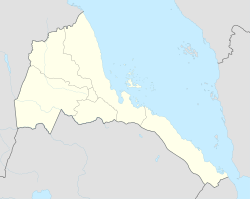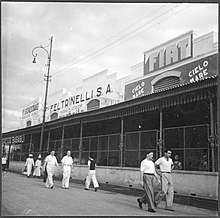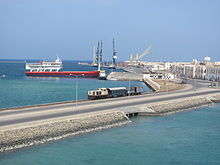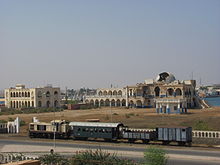Massaua
| Massaua | ||
|---|---|---|
|
|
||
| Coordinates | 15 ° 36 ' N , 39 ° 27' E | |
| Basic data | ||
| Country | Eritrea | |
| Semienawi Kayih Bahri | ||
| ISO 3166-2 | ER-SK | |
| height | 8 m | |
| Residents | 47,799 (2009) | |
Massaua ( Massawa or Mitsiwa , also Bats'e or Badhe , Tigrin ምጽዋዕ or ባጽዕ, Arabic مصوع Musawwaʿ , DMG Muṣawwaʿ ) is a port city in Eritrea on the Red Sea . The city has a well-developed port, the largest in Eritrea, with significant fishing and salt marshes . Massaua is the capital of the Semienawi Kayih Bahri region and the country's second largest city.
Geographical location
The city is located on the mainland and two offshore islands. The historical center of the city lies on the outer of these two islands, a 1000 m long, 300 m wide coral island with no fresh water sources. This island is connected by a 440 m long dam with the island of Taulud , which was uninhabited until the 19th century , from which a 1030 m long second dam leads to the mainland.
Massaua is about 2 meters above sea level. It has a hot desert climate with extremely high humidity .
population
Massaua has 47,799 inhabitants (2009 calculation).
Population development:
| year | Residents |
|---|---|
| 1893 (estimate) | 16,400 (including 15% Italians) |
| 1905 (estimate) | 6,500 |
| 1928 (estimate) | 15,000 (including 25% Italians), plus the Italian garrison |
| 1962 (estimate) | 21,300 |
| 1984 (census) | 15,441 |
| 1962 (estimate) | 21,300 |
| 1983 (estimate) | 16,576 |
| 1985 (estimate) | 60,000 |
| 1990 (estimate) | 30,000 |
| 1993 (estimate) | 19,404 |
| 2009 (calculation) | 47,799 |
history
middle Ages
The Aksumite port city of Adulis was located near Massaua . In the 10th century, Arab writers mentioned Massaua under the name Bade (or Base ).
The city became significant when the port of Adulis silted up from the 11th century and the rise of the Sultanate of the Dahlak Islands began. The sultanate controlled the city until the 14th century, even if claims were made by the Abyssinian side. The city had to pay tribute to the Abyssinian governors of Tigray . The city's ruling class consisted of Arab and Nigerian merchants. Culturally, Massaua was the center of Islam in the coastal region. Their Sharia courts were located here.
Early modern age
In the early 16th century, Massaua was a strategically important position and highly competitive in the war between the Kingdom of Portugal and the Ottoman Empire in the Red Sea. With the conquest of Eritrea by Özdemir Pasha , Massaua became Ottoman in 1557 and part of the Habesch province . However, since the Ottomans did not succeed in occupying the hinterland and the local representatives of the Ottomans were increasingly locals, ties to Istanbul loosened during the 18th century. The province of Habesch was dissolved and Massaua was administratively subordinate to the province of Jeddah. From the beginning of the 19th century, foreign interests again manifested themselves in the city, British and French , but initially also Egyptian . In 1846 the Ottoman Empire leased Massaua to its autonomous province of Egypt. Ismail Pascha , Wali of Egypt, bought the city for life in 1865, but a year later Massaua was finally given over to Egypt. The mainland was also increasingly populated. Here also were Roman Catholic and Protestant missions down. In the 19th century, Massaua was an important trading city in traffic between Abyssinia , Sudan , as well as Europe and India . Here was the largest and safest port on the Red Sea.
Under Egyptian rule it became the capital of the new Egyptian province "Red Sea and East Sudan", which expanded rapidly until 1876, and Werner Munzinger , who also resided in Massaua, was one of the governors from 1873 . The inhabitants of the city were Nubians , Danakil , Habescha , Oromo , Indians and Greeks .
Colonial times
During the Mahdi uprising , the Kingdom of Italy occupied the city on February 5, 1885, which was administered as an Italo-Egyptian condominium until the Egyptian governor was deposed on December 2 . Despite the Italian defeat of Dogali against the Abyssinian army, it became the capital of an Italian protectorate , from which the Colonia Eritrea emerged in 1890 . The port was greatly expanded under Italian rule and a hospital was built. Under Italian rule, the city was fortified and a new, European-influenced district emerged on the island of Taulud. Massaua remained the capital of the colony until 1897, when it lost this function to Asmara . As a result, the population of Massaua shrank massively.
From 1887, first the military and later the Italian colonial administration pushed ahead with the construction of a railway line in the direction of Asmara with the - never reached long-term destination - Sudan. A salt production plant also went into operation.
In 1921, large parts of the old town were destroyed by an earthquake. It took years for her to recover. The Italian preparations for the Italo-Ethiopian War (1935–1936) contributed greatly to this . For this reason, the 74 km long Massaua-Asmara cable car was built, which started from here. In 1940 the port of Massaua was the best developed between Alexandria and Cape Town . After the Italian defeat in World War II , the British administration looted the facilities and sold them as spoils of war and reparations . This and the rise of the rival port of Assab led the city into an economic crisis that was exacerbated by the federation with Ethiopia in 1952 and its colonial policy. The Ethiopian Navy established its headquarters here and a US base was created . Due to the repressive policies of Ethiopia, a significant part of the Muslim population left the city.
independence
The War of Independence began in Massaua in 1977, when the liberation front took parts of the mainland Massaua, but could not conquer the islands and had to give up their conquests again in 1978. Ethiopia then expanded Massaua as a garrison . The port facilities, the naval base and the fuel depots were repeatedly the target of attacks by the insurgents, which in 1982 and 1986 led to large fires and parts of the civilian population to flee: The population was reduced by half. At the beginning of February 1990 the final battle for Massaua took place. The Eritrean Navy destroyed the Ethiopian ships in the harbor and, after the Derg prevented the Ethiopian troops from surrendering, the liberation fighters stormed the islands, the western sides of which were severely destroyed by artillery fire . The number of dead was about 12,000. The port facilities were badly damaged during the fighting. In the period that followed, the port of Massaua was the main transhipment point for international food aid, but had only a very limited capacity due to the destruction caused by the war. Reconstruction began in 1994. In the Eritrea-Ethiopia War (1998-2000), however, there were again air raids by the Ethiopian air force on the city.
Today Massaua is the second most important city in the country after Asmara. The president maintains a branch of his office here.
traffic
port
The port of Massaua is the largest and most important in the country. Due to Eritrea's low economic output, the turnover of goods there is quiet. Due to the country's policy, which tends to hinder tourism, it is not an attractive destination for cruise ships either.
railroad
The Massaua – Biscia railway begins in the port of Massaua, right in front of the old town. It runs over both dams to the mainland. The "main station" was formerly on the island of Taulud. Railways across the country were severely damaged during the War of Liberation and were unusable between 1976 and 1994. Since then, the line to Asmara has been made operational again. After 1994 there was a suburban train service in Massaua, but this was discontinued. Today there is no longer any freight or scheduled passenger traffic on the route. There are only special trips for railway enthusiasts and trips for route maintenance.
Street
Private car traffic in Massaua is comparatively low. Cyclists and donkey-drawn carts make up a large proportion of inner-city vehicle traffic. Truck traffic is important, as all goods traffic in the port is transferred to and from road traffic on the land side. Massaua is the starting point of the important Massaua-Asmara road connection .
Airport
Massaua has an airport located on the Massaua-Asmara road. It is served irregularly about once a month and only by Eritrean Airlines .
Attractions
Old town
The - in spite of all the destruction - still very important and extraordinarily picturesque historic old town of Massaua on the island of Batse is an outstanding testimony to Arab and Ottoman architecture. However, this ensemble still shows damage from the war of liberation and is undersupplied in terms of monument conservation due to the weak economic situation in the country . Some of the historical cultural monuments are falling into disrepair, and the district is sluggish .
Imperial palace
On the island of Taulud, opposite the port, is the Imperial Palace of Massaua . Its core dates back to the Ottoman period, but mainly from the 19th century and was last used by Emperor Haile Selassie . It was badly damaged in the war of liberation and is now in ruins.
literature
- Jean-Bernard Carillet: Ethiopia & Eritrea . 2009.
- Dan Connell & Tom Killion: Historical Dictionary of Eritrea . 2nd edition Lanham 2011, keyword: "Massawa" .
Web links
- Eritrea in Picture: Massawa Numerous photos of the old town and the port
- Massawa and the Red Sea. History and Culture. (PDF; 8.5 MB) Text on an exhibition by the Alliance Française in Asmara. Trilingual. English pp. 38-74
Individual evidence
- ↑ Archived copy ( Memento of the original dated December 29, 2011 in the Internet Archive ) Info: The archive link was automatically inserted and not yet checked. Please check the original and archive link according to the instructions and then remove this notice.
- ^ Wilhelm H. Schoff: The Periplus of the Erythraen Sea. Travel and trade in the Indian Ocean by a merchant of the first century. New Delhi 2001, p. 23
- ^ Estelle Sylvia Pankhurst: Eritrea on the Eve . London 1952.
- ↑ Cf. Dan Connell, keyword: "Massawa Battles" , p. 364ff.









